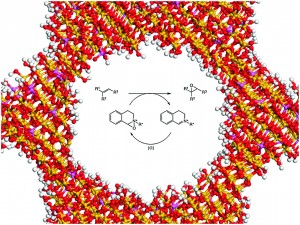The majority of laboratory scale organic reactions rely on homogenous catalysts which are usually removed via chromatography, often a time-consuming process that generates solvent and silica gel waste. These separation issues become untenable for large scale industrial processes and as a result, heterogeneous catalysts are preferred for ease of isolation. To be adopted as an industrial process, the reaction must also satisfy high standards of conversion to product, costliness and enantioselectivity.
This article details the asymmetric epoxidation of alkenes using heterogeneous iminium micro- and mesoporous supported organocatalysts with TPPP (tetraphenylphoshonium monopersulfate) as a stoichiometric oxidant. This method holds potential for industrial production as the catalyst can be reused after simple filtration and washing and avoids the use of expensive transition metals. Enantiopure epoxides, which are valuable synthetic building blocks, were obtained in high yields and enantioselectivities for select alkenes. Successive uses of the catalyst do however result in lower yields for reasons currently unknown to the authors. Nonetheless this report may serve as valuable precedent for future efforts towards a reusable heterogeneous chiral iminium catalyst for epoxidation.
Read the full article here:
Towards heterogeneous organocatalysis: chiral iminium cations supported on porous materials for enantioselective alkene epoxidation
Philip C. Bulman Page, Andrew Mace, Damien Arquier, Donald Bethell, Benjamin R. Buckley, David J. Willock, and Graham J. Hutchings
Catal. Sci.Technol., 2013, DOI: 10.1039/c3cy00352c
 Tien Nguyen is a web contributor working towards her PhD in David Nicewicz’s research group at the University of North Carolina at Chapel Hill, USA. Her current area of research focuses on anti-Markovnikov hydroamination of alkenes using photoredox catalysis.
Tien Nguyen is a web contributor working towards her PhD in David Nicewicz’s research group at the University of North Carolina at Chapel Hill, USA. Her current area of research focuses on anti-Markovnikov hydroamination of alkenes using photoredox catalysis.











